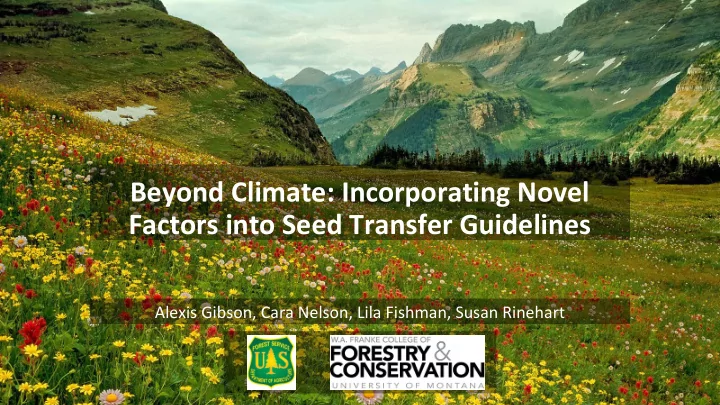

Beyond Climate: Incorporating Novel Factors into Seed Transfer Guidelines Alexis Gibson, Cara Nelson, Lila Fishman, Susan Rinehart
Seed Transfer Zones • Geographic genetic variation • Map genetic variation on landscape • Adapted to local conditions St Clair et al. 2014
Potential Limitations 1. Are the most important environmental factors included? 2. Are there other genetic factors that impact fitness?
Potential Limitations 1. Are the most important environmental factors included? • Soils • Water availability, nutrients, pH, minerals
Potential Limitations 1. Are the most important environmental factors included? • Soils • Water availability, nutrients, pH, minerals • Extreme and moderate differences (e.g. Wright, Stanton, Scherson 2006; Macel et al. 2007)
Potential Limitations 1. Are the most important environmental factors included? • Soils • Water availability, nutrients, pH, minerals • Extreme and moderate differences • Data quantity and quality
Data Availability • Bromus carinatus (Johnson et al. 2010) • Seven of eight soil variables related to variation in traits • ~30% populations missing data
Mountain Brome • Wide range and use • Combine climate and soil variables • New availability of soils data • Statewide soil data (NASIS) • NRCS database (SSURGO)
Mountain Brome • 60 populations • 11 National Forests in Montana and Idaho • 2 years common garden • R 2 and AIC model selection
Size Survival Vigor Water Use
Vigor Climate + Soils Precipitation as snow Available water content Organic Carbon Soil temperature regime
Size Survival Vigor Water Use Climate + Soils Climate End of growing season Annual precipitation Mean coldest month temperature
Size Survival Vigor Water Use Climate + Soils Soils Climate Soils Soil order Available water content Clay content
CLIMATE + SOILS MODELS • 6 ecotypes • 2 main • Mid vigor, small plants
CLIMATE + SOILS MODELS CLIMATE ONLY • 6 ecotypes • 2 ecotypes • 2 main • 1 main • Mid vigor, small plants • High vigor, small plants
Soils Matter • Increase variation explained by the model • Water use efficiency • R 2 : 9% → 20% • Less extreme for other traits • 4 – 7%
Potential Limitations 1. Are the most important environmental factors included? 2. Are there other genetic factors that impact fitness?
Potential Limitations 2. Are there other genetic factors that impact fitness? • Polyploidy • 13% species have multiple cytotypes (Severns et al. 2006)
DIPLOID (2x)
TRIPLOID TETRAPLOID DIPLOID (3x) (4x) (2x)
Potential Limitations 2. Are there other genetic factors that impact fitness? • Polyploidy • 13% species have multiple cytotypes (Severns et al. 2006) • Cytotypes may not segregate by habitat (e.g. Baack 2004)
Potential Limitations 2. Are there other genetic factors that impact fitness? • Polyploidy • 13% species have multiple cytotypes (Severns et al. 2006) • Cytotypes may not segregate by habitat (e.g. Baack 2004) • Fitness and population viability
Adapted from Burton and Husband 2000
Bluebunch Wheatgrass • Most populations diploid (2x) • Tetraploid (4x) in northern range (Larson 2004) • Gibson, Fishman, and Nelson. 2016. Restoration Ecology.
2x 4x Mixed
2x 4x Mixed
Mixing it Up • Environment does not divide cytotype • Seed transfer zones will not prevent mixing (Severns et al. 2013)
Conclusions • Soils during transfer zone development • Impact on number, type, and distribution of ecotypes expected
Conclusions • Soils during transfer zone development • Polyploidy considered pre-development • Better information on presence of cytotypes • Location of cytotpes
Conclusions • Soils during transfer zone development • Polyploidy considered pre-development • Cytotypes considered post-transfer zone development • Rare species and isolated populations
“Make it look like natural selection.”
The preceding presentation was delivered at the 2017 National Native Seed Conference Washington, D.C. February 13-16, 2017 This and additional presentations available at http://nativeseed.info
Recommend
More recommend